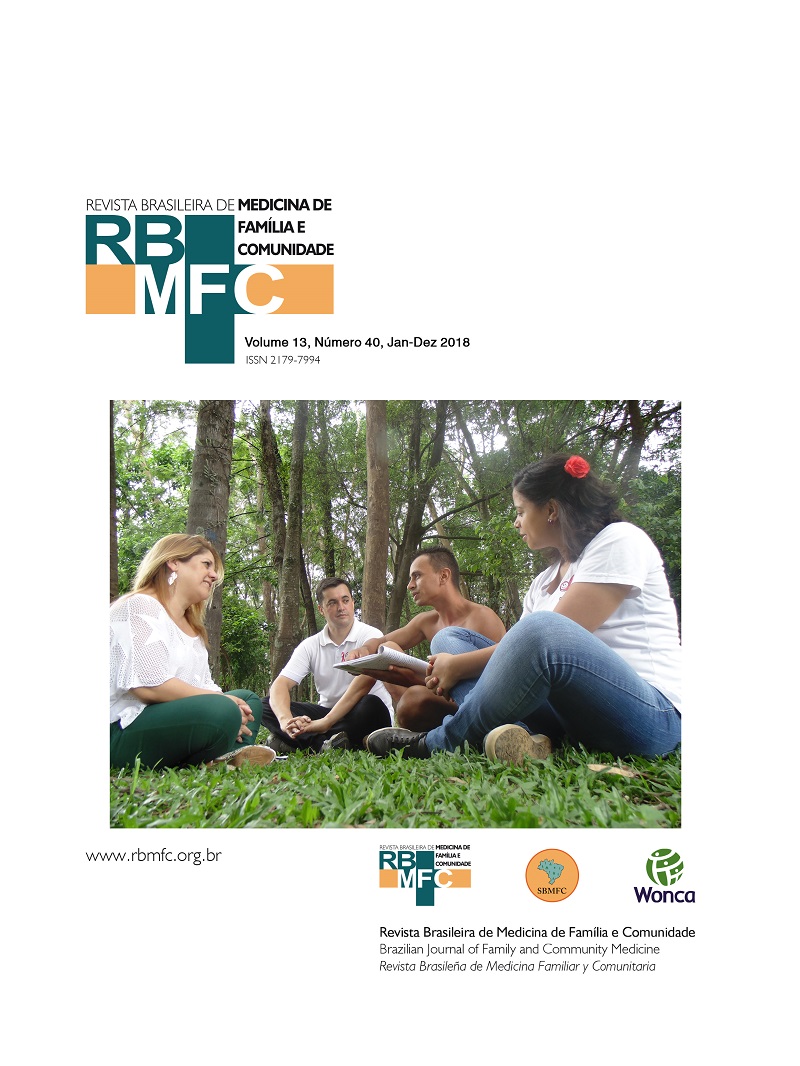Quaternary Prevention and Medical Education: an Integrative Review after National Curricular Guidelines of the Medicine Course of 2014
DOI:
https://doi.org/10.5712/rbmfc13(40)1694Keywords:
Quaternary Prevention, Education, Medical, ReviewAbstract
Introduction: According to the Resolution No. 3, 2014, from the Brazilian Ministry of Health, that establishes the National Curricular Guidelines of the Medicine Undergraduate Course. According to the guidelines, the medicine student must have general, humanistic, critical, reflexive and ethical training, with capacity to act at the different levels of health care, among them, prevention. The diagnostic investigation should be based on the best scientific evidence and according to the needs of the person. In this sense, quaternary prevention and its principles meet the objectives of the DNC. Objectives: To perform the intersection in Brazilian journals between the quaternary prevention and medical teaching after the implementation of the DNC of 2014. Methods: Integrative review of the articles available on CAPES, Scielo, PubMed and Google Academic platforms, from 2014 until October 2017, by the keywords “quaternary prevention” and “education”. Exclusion criteria includes articles sponsored by pharmaceutical industries, unavailable in their entirety, without abstract and foreign articles. Results: 33 documents were found and 9 articles were selected for analysis, focused mainly on the practice of quaternary prevention. Only 3 studies allude to medical education. Conclusion: Quaternary prevention is a subject of great relevance in medical practice, however, it is still deficient in graduation, based on the restricted productions available. Despite the new guidelines of the medical course, medical education in the current scenario is predominantly focused on specialties, hindering the integral and person-centered performance.
Downloads
Metrics
References
Brasil. Ministério da Educação. Conselho Nacional de Educação. Resolução Nº 3, de 20 de junho de 2014. Institui as Diretrizes Curriculares Nacionais do Curso de Graduação em Medicina e dá outras providências. Brasil. Ministério da Educação; 2014. [acesso 2017 Out 2017 16]. Disponível em: http://www.fmb.unesp.br/Home/Graduacao/resolucao-dcn-2014.pdf
Bentzen N. An international glossary for general/family practice. Fam Pract. 1995 [acesso 2017 Out 16];12(3):341-69. http://dx.doi.org/10.1093/fampra/12.3.341 DOI: https://doi.org/10.1093/fampra/12.3.341
Stewart M, Brown JB, Weston WW, McWhinney IR, McWilliam CI, Freeman TR. Medicina centrada na pessoa: transformando o método clínico. 2ª ed. Porto Alegre: Artmed; 2010.
Starfield B. Atenção Primária: equilíbrio entre necessidades de saúde, serviços e tecnologia. Brasília: Ministério da Saúde/UNESCO; 2002.
Jamoulle M, Gomes LF. Prevenção Quaternária e limites em medicina. Rev Bras Med Fam Comunidade. 2013 [acesso 2017 Out 16];9(31):186-91. http://dx.doi.org/10.5712/rbmfc9(31)867 DOI: https://doi.org/10.5712/rbmfc9(31)867
Gérvas J, Pérez-Fernández M. São e salvo: E Livre de Intervenções Médicas Desnecessárias. Porto Alegre: Artmed; 2016.
Moher D, Liberati A, Tetzlaff J, Altman DG; PRISMA Group. Preferred reporting items for systematic reviews and meta-analyses: the PRISMA statement. PLoS Med. 2009 [acesso 2018 Jan 14];6(7):e1000097. http://dx.doi.org/10.1371/journal.pmed.1000097 DOI: https://doi.org/10.1371/journal.pmed.1000097
Neiva TS, Vianna LG, Moraes CF. Prevenção em saúde na prática médica: da primária à quaternária. Rev Eletr Gestão Saúde. 2015 [acesso 2017 Out 16];6(2):1418-27. http://dx.doi.org/10.18673/gs.v6i2.22477 DOI: https://doi.org/10.18673/gs.v6i2.22477
Wagner HL, Soares CR, Moreira JV. Literatura médica e a ética em pesquisa: desafios para a prevenção quaternária. Rev Bras Med Fam Comunidade. 2015 [acesso 2017 Out 16];10(35):1-4. http://dx.doi.org/10.5712/rbmfc10(35)1116 DOI: https://doi.org/10.5712/rbmfc10(35)1116
Modesto AAD, Lima RLB, D’Angelis AC, Augusto DK. Um novembro não tão azul: debatendo rastreamento de câncer de próstata e saúde do homem. Interface (Botucatu). 2018 [acesso 2017 Out 16];22(64):251-62. http://dx.doi.org/10.1590/1807-57622016.0288 DOI: https://doi.org/10.1590/1807-57622016.0288
Norman AH, Tesser CD. Prevenção quaternária: as bases para sua operacionalização na relação médico-paciente. Rev Bras Med Fam Comunidade. 2015 [acesso 2017 Out 16];10(35):1-10. http://dx.doi.org/10.5712/rbmfc10(35)1011 DOI: https://doi.org/10.5712/rbmfc10(35)1011
Gross DMP, Camacho ALCF, Lage LR, Daher DV, Mora CP. Prevenção quaternária na gestão da atenção primária à saúde: revisão integrativa. Rev Enferm UFPE On Line (Recife). 2016 [acesso 2017 Out 16];10(Supl. 4):3608-19. Disponível em:
https://periodicos.ufpe.br/revistas/revistaenfermagem/article/download/
/12633. DOI: 10.5205/reuol.9681-89824-1-ED.1004sup201613
Tesser CD, Knobel R, Andrezzo HFA, Diniz SG. Violência obstétrica e prevenção quaternária: o que é e o que fazer. Rev Bras Med Fam Comunidade. 2015 [acesso 2017 Out 16];10(35):1-12. http://dx.doi.org/10.5712/rbmfc10(35)1013 DOI: https://doi.org/10.5712/rbmfc10(35)1013
Pizzanelli M, Almenas M, Quirós R, Pineda C, Cordero E, Taureaux N, et al. Prevenção Quaternária: Ética Médica, Avaliação e Eficiência nos Sistemas de Saúde. Rev Bras Med Fam Comunidade. 2016 [acesso 2017 Out 16];11(Suppl 2):75-85. http://dx.doi.org/10.5712/rbmfc11(0)1388 DOI: https://doi.org/10.5712/rbmfc11(0)1388
Martins C, Godycki-Cwirko M, Heleno B, Brodersen J. Quaternary prevention: reviewing the concept. Eur J Gen Pract. 2018 [acesso 2018 Dez 2];24(1):106-11. http://dx.doi.org/10.1080/13814788.2017.1422177 DOI: https://doi.org/10.1080/13814788.2017.1422177
Tesser CD, Norman AH. Differentiating clinical care from disease prevention: a prerequisite for practicing quaternary prevention. Cad Saúde Pública. 2016 [acesso 2017 Out 16];32(10):e00012316. http://dx.doi.org/10.1590/0102-311X00012316 DOI: https://doi.org/10.1590/0102-311X00012316
Gomes LF, Gusso G, Jamoulle M. Teaching and learning quaternary prevention. Rev Bras Med Fam Comunidade. 2015 [acesso 2018 Dez 2];10(35):1-14. http://dx.doi.org/10.5712/rbmfc10(35)1050 DOI: https://doi.org/10.5712/rbmfc10(35)1050
Norman AH, Tesser CD. Quaternary prevention in primary care: a necessity for the Brazilian Unified National Health System. Cad Saúde Pública. 2009 [acesso 2018 Dez 2];25(9):2012-20. http://dx.doi.org/10.1590/S0102-311X2009000900015 DOI: https://doi.org/10.1590/S0102-311X2009000900015
Downloads
Published
How to Cite
Issue
Section
License
By submitting a manuscript to the RBMFC, authors retain ownership of the copyright in the article, and authorize RBMFC to publish that manuscript under the Creative Commons Attribution 4.0 license and identify itself as the vehicle of its original publication.















